DISCLOSURE: If I link to relevant products or helpful info it may be an affiliate link, meaning I may earn a small commission. As an Amazon Associate & other affiliate, I earn from qualifying purchases at no extra charge to you. The views & opinions are my own. Please see the disclaimer and privacy policy.
Last Updated on February 21, 2023
About Hindu Temples Around the World
Hinduism is a common religion in countries across the globe and there are beautiful Hindu temples around the world with artistic shrines and grand statues dedicated to the Hindu gods. These Hindu temples around the world come in different shapes and sizes, incorporate elaborate architectural designs, and with the building materials they use, they all reflect the beauty of the religion and the gods that they represent.
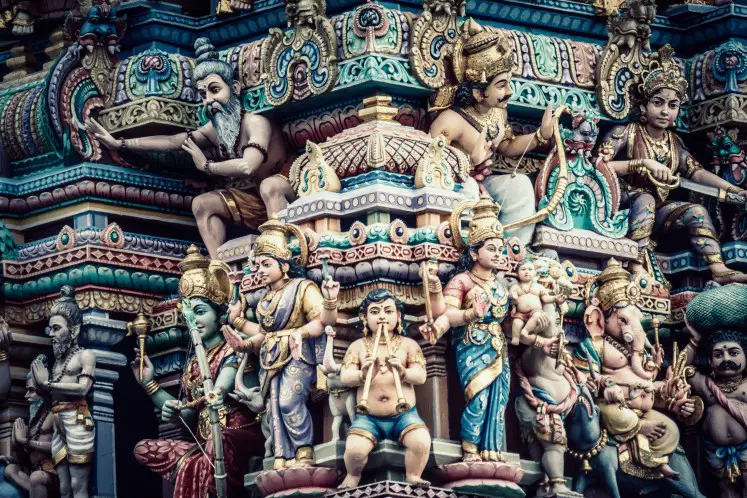
Travel to Hindu Temples Around the World
There are famous Hindu Temples around the world in countries near and far. The Hindu temple is a symbolic house for the divine and a place for the Hindu believers to gather in front of the gods. India itself has over 2 million Hindu temples, but they are sprinkled across the world, allowing Hindus worldwide to gather in worship and show their devotion to the gods.
Festivals of Holi, Diwali, and different types of worships, pujas, are all done in the temples. Wedding rituals are particularly beautiful. Read about all the elaborate rituals and clothing from my participation at a Hindu temple wedding in Trinidad.
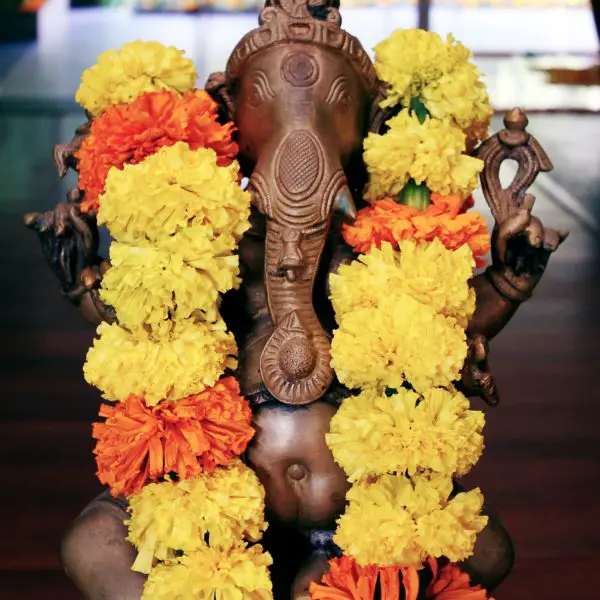
What are the 16 most beautiful Hindu temples in the world?
Travel bloggers around the world have selected some of the most beautiful Hindu temples from around the world for your delightful viewing pleasure. They have included a little bit of Hindu temple history and Hindu temple facts from their visits. You can marvel at these religious wonders from your cozy reading chair and perhaps make plans to see them for yourself on a future Bucket-List Vacation! If you choose to put one on your next destination travel list, make sure that you familiarize yourself with temple etiquette dos and don’ts, especially if this is your first visit to a temple.
Where are the 16 most beautiful Hindu temples in the world?
Beautiful Hindu Temples in TRINIDAD
Temple in the Sea: built through perseverance and strength

This beautiful Hindu temple is located in Trinidad in the Caribbean. Trinidad is a cultural melting pot with many customs and traditions of India. There are many Hindu temples throughout the island of Trinidad, reflecting that Hinduism is one of its main religions.
The Temple in the Sea is located in South Trinidad ….and yes, actually it IS in the Caribbean Sea! The story of the temple’s creation is one of perseverance. Its builder and designer, Sewdass Sadhu, first built the temple by hand only to have it destroyed by the government who said that they owned the land. After serving his jail time, Sewdass Sadhu rebuilt the temple, THIS TIME in the water, since the government did not own the sea! Brilliant idea!
Later a walking pier was added so that the temple could be reached at any time, including high tide.
This temple is adorned with many figures and statues on the inside and outside. There are also many colorful flags surrounding the temple. All of the golden dieties and flags waving in the wind give an exotic air to the Temple in the Sea.
Read more about the Temple in the Sea

Beautiful Hindu Temples in CAMBODIA
Angkor Wat: the largest religious monument in the world
Visited by Monica from This Rare Earth
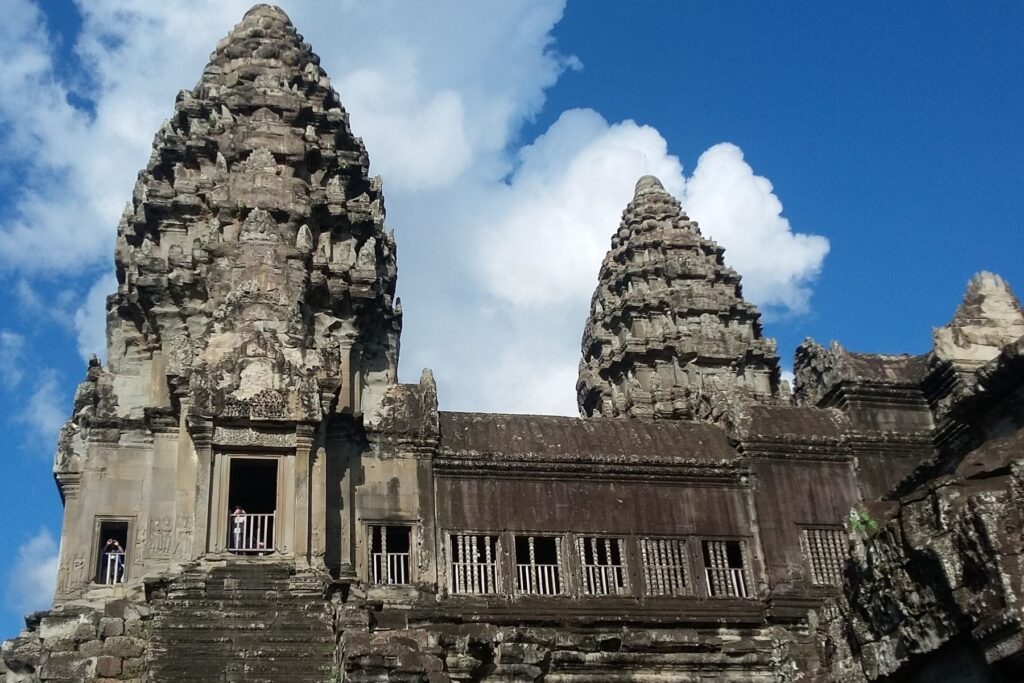
Angkor Wat is an incredibly impressive and famous temple in Siem Reap, Cambodia, and is the largest religious monument in the entire world. Built in the early 12thcentury, the Angkor Archeological Complex has survived the test of time and has had multiple uses over the years. King Suryavarman II dreamed up Angkor Wat as both a state temple and also as his eventual mausoleum.
By the end of the 12thcentury, the country’s national religion switched from Hindu to Buddhism, and the temple followed suit. One of the most interesting and memorable things I experienced here was easily finding traces of both religions all over the complex. Vishnu can be found in Bas Relief carvings in the walls, as well as a large Buddha statue still used for offerings by locals. It’s quite amazing to see both religions represented in the historical structure in one beautiful temple.
I remember the first time I saw photos of this ancient complex – I was intrigued by the history and construction of the place, but also in awe of the lush greenery surrounding it. Once I visited in real life, it didn’t disappoint. In fact, it was far more amazing than I even imagined! Something I will never forget is watching the incredible sunrise at Angkor Wat, perfectly reflected in the rectangular pools, or watching the moon come up over the unique spires while the monkeys caused a ruckus in the background. Somehow Angkor Wat is both serene and lively, all at the same time.
Building such a large and impressive temple complex was not only a way for King Suryavarman II to prove his power to the world but it also a way to ask for protection from the gods. It is believed that Hindu temples serve not as places for worship but as actual homes for the gods. So, to build the grandest temple on earth was sure to grant his kingdom protection.
Cambodia is a special place, and Angkor Wat in Siem Reap was one of the most memorable stops in the entire country. In fact, it’s a highlight for me across all countries I have visited. This amazing temple should be on every traveler’s bucket list!
Beautiful Hindu Temples in LAOS
Vat Phoe: a tranquil and secluded religious complex in Laos
Visited by Marlo from Along Came An Elephant
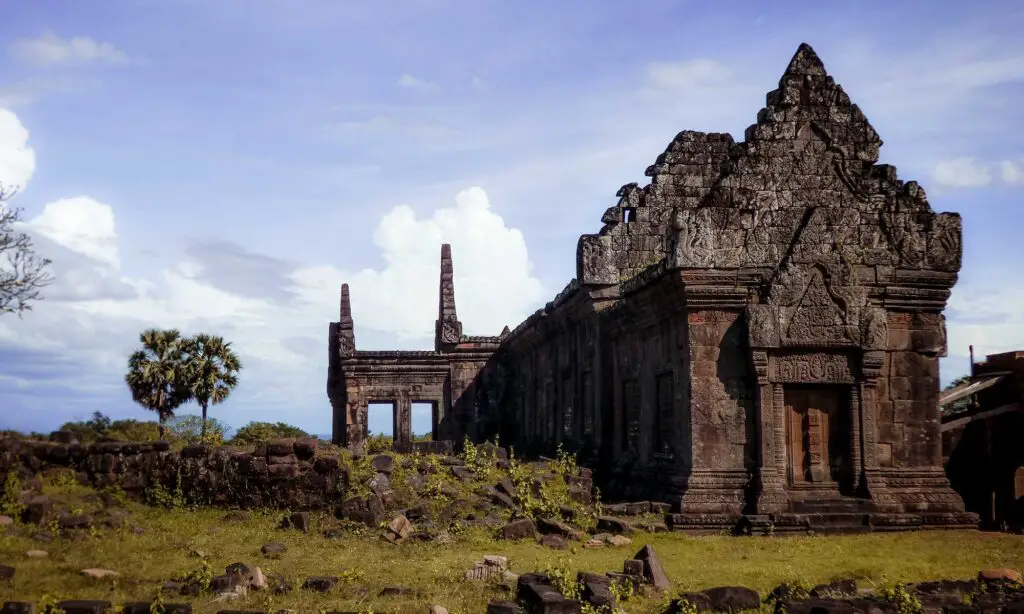
The jungle-claimed temple complex of Angkor Wat in Cambodia is world-famous, and rightly so. The drawback of its acclaimed status is that you have to share its splendidness with thousands of other Khmer Empire aficionados. But what if you could enjoy the beauty of Hindu architecture in pure tranquility? I have your attention now, haven’t I?!
Well, I found myself exploring the Vat Phoe temple complex almost completely by myself, an experience rivaling the most beautiful Hindu temples around the world. The country of Laos has many interesting places to visit as well as a beautiful Hindu temple to appreciate!
In the deep south of Laos’ Champassak region, one can find the remarkably well-preserved Vat Phoe temples, built on the flanks of Phoe Kao mountain. As I slowly made my way through the site, more and more temples revealed themselves, like the opening of the theatre curtains of a Broadway show. Each turn offering new perspectives and uncovering new statues. To reach the shrine, I had to climb a set of uneven stone stairs, sunken into the mountain. The centennial trees provided ample shade but the scented magnolias and incense of the shrine above let me know that I was nearly at the top.
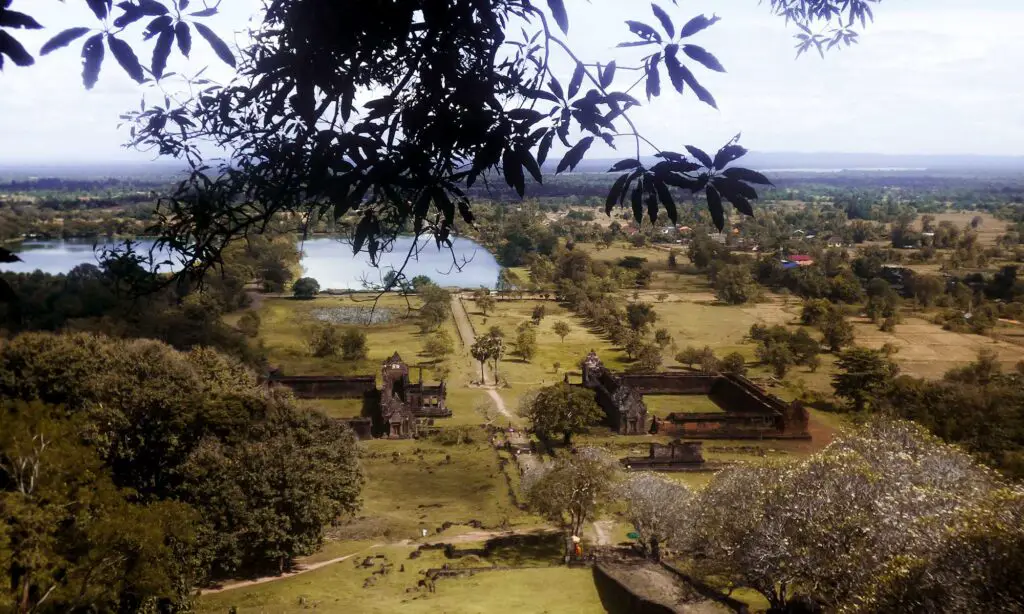
The small shrine felt intimate, besides two praying monks, no other visitors were around. Its prime location unveiled superb views over the 1,000 years old landscape and the remaining archaeological site below. While I stood there at the top of Vat Phou, I couldn’t imagine a more peaceful way to get in touch with Hindu culture. The French colonial heritage city of Paksé is an excellent gateway to discovering Laos’ Bolaven Plateau. The Bolaven Plateau’s hidden gems- coffee plantations, tropical waterfalls, and the Vat Phoe UNESCO heritage site – reveal themselves only to the adventurous at heart. Peppered throughout Laos’ tropical jungle these sites can be explored on a Bolaven Plateau motorbike trip.
Beautiful Hindu Temples in MALAYSIA
Batu Caves: home of the Thaipusam festival
Visited by Victoria from Guide your Travel
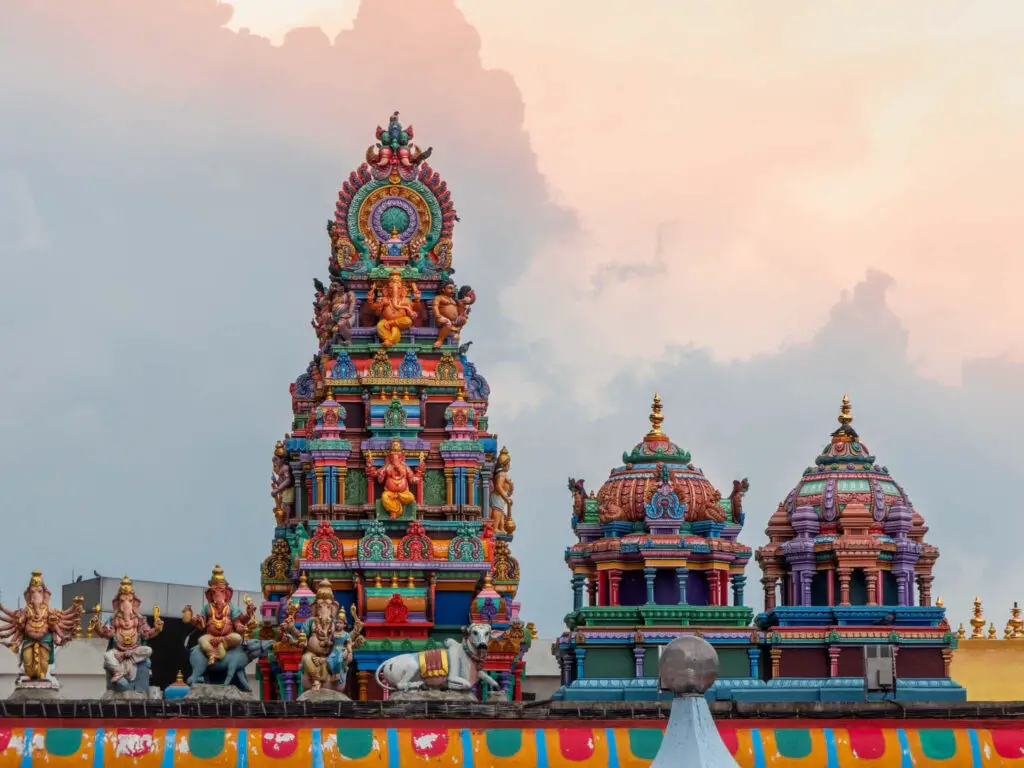
The Batu Caves are one of Malaysia’s most popular tourist attractions, one of the most popular Hindu pilgrimage destinations outside of India, and one of the most beautiful Hindu temples in the world. The caves sit just 13 kilometers outside of the nation’s capital city Kuala Lumpur. They are quick to reach via train which makes them easily accessible to devotees and tourists. Entrance to the caves is completely free so it is no surprise that millions of people visit them every year.
The complex around the Batu Caves is home to several different temples, the most famous being located within the main caves. 272 steep steps lead to the entrance of the cave and the main temple. They were painted in rainbow colors in 2018 which considerably increased tourism. Outside of the cave, there is a 42-meter tall gold statue of the Hindu Lord Murugan. The statue and the steps are the subjects of many photos and one of the most recognizable places in all of Malaysia.
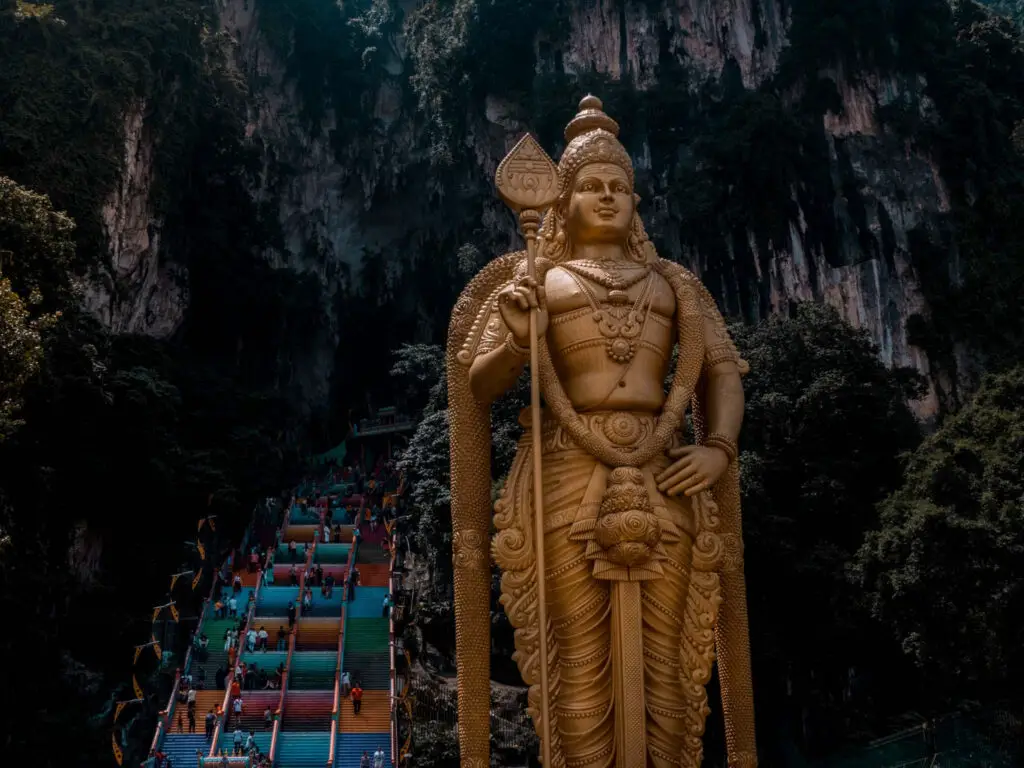
Inside the Batu Caves, it is usually eerily quiet except for the screams of the many monkeys that populate the area. Visitors should be respectful and wear clothing that covers their ankles and shoulders. Unless you are a practicing Hindu it is not encouraged to enter the temples or take part in the daily rituals. The Batu Caves are a religious site and showing respect is important. The temples are not very large and their exterior is stunningly beautiful so you can still appreciate this magical place without actually entering the temples.
The Batu Caves are home to the famous Thaipusam festival which doesn’t exist anywhere else in this form. Up to 1 Million people visit the temples within the caves during the festival which is held on the full moon of the Tamil month, which is usually January or February. Devotees carry offerings up the steps to the cave and in some cases pierce their bodies in multiple places with objects hanging from the piercings. This is done in a sort of trance with no pain or bleeding. While the Thaipusam Festival is a magical time to visit the Batu Caves keep in mind that it will be extremely crowded. You most likely won’t have the chance to enter the caves or see much of the temples.
The Batu Caves are one of the most unique and incredible Hindu temples there is. The temples are stunningly beautiful and just a short train ride from the city. Definitely not to be missed if you’re visiting Kuala Lumpur in Malaysia.
Beautiful Hindu Temples in INDONESIA
Tanah Lot Temple: the rock island temple in Bali
Visited by Karlie Cummins from Bali Buddies
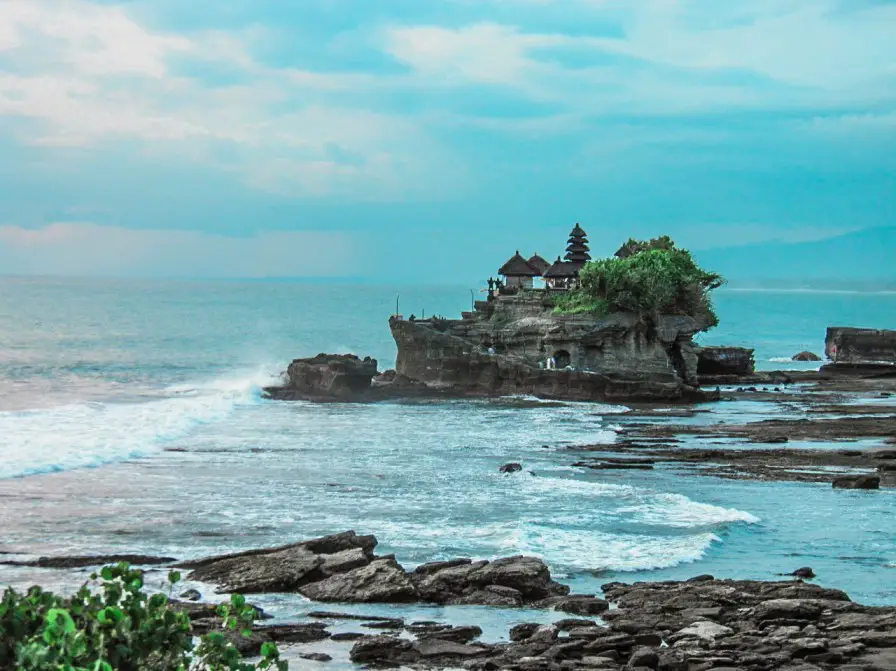
When visiting Bali you can’t help but be emersed in the Hindu religion and its customs. From the thousands of daily offerings laid out each morning, to the ceremonial clothing you see on the locals, to the intricate, handmade decorations that line the streets at special times of the year. I am always mesmerized in Bali at the many temples, that are attended every day of the year. Every home and store has a small temple in it (sometimes more than one!) and there are many large and famous temples in Bali that hold so much history and are not only important to the Hindu religion in Bali, but also draw crowds of visitors each day. I’ve visited many of Bali’s most famous temples but I choose Tanah Lot Temple, Bali’s ‘Temple in the Sea,’ as one of the most beautiful Hindu temples in the world.
Tanah Lot temple is perched on a rock within the ocean and can only be accessed during low tide. If you visit during high tide, the temple will be completely surrounded by water and inaccessible, but I find it the most beautiful view during the high tide. Visitors are allowed to walk over to the temple during low tide, but only Balinese people are allowed to enter the temple itself. It has become one of Bali’s most famous landmarks and can be seen on many postcards and promotions about Bali. Even though visitors can’t access the temple itself, it is well worth visiting to view Tanah Lot temple at the many lookouts and restaurants that have the temple as their backdrop. The best time of day to visit the temple is at sunset. This part of the island gets the most stunning sunset view and seeing the sunset behind this iconic temple is a sight you soon won’t forget.
The temple is located in the Tabanan Regency in the village of Beraban. It is about 20km from the Kuta region. There is a small entrance fee to enter the area and a short walk to reach the best viewing points. The walk to the temple is lined with local sellers, selling Balinese handicrafts, clothing, and souvenirs. You may be lucky enough to visit during a time when there is a ceremony happening. During this time, you will see the Balinese dressing in their ceremonial outfits and making their way at low tide across to the temple carrying many offerings and umbrellas. You will see them praying and laying out the offerings.
When visiting Bali be sure to take some time to visit some of the beautiful Hindu temples. Be sure to be respectful as these are sacred places of worship. You will be rewarded with stunning scenery and an insight into the intricate world of the Hindu religion and history.
Pura Ulun Danu Beratan: beautiful temple floating on a mountain lake
Visited by Mal from Raw Mal Roams
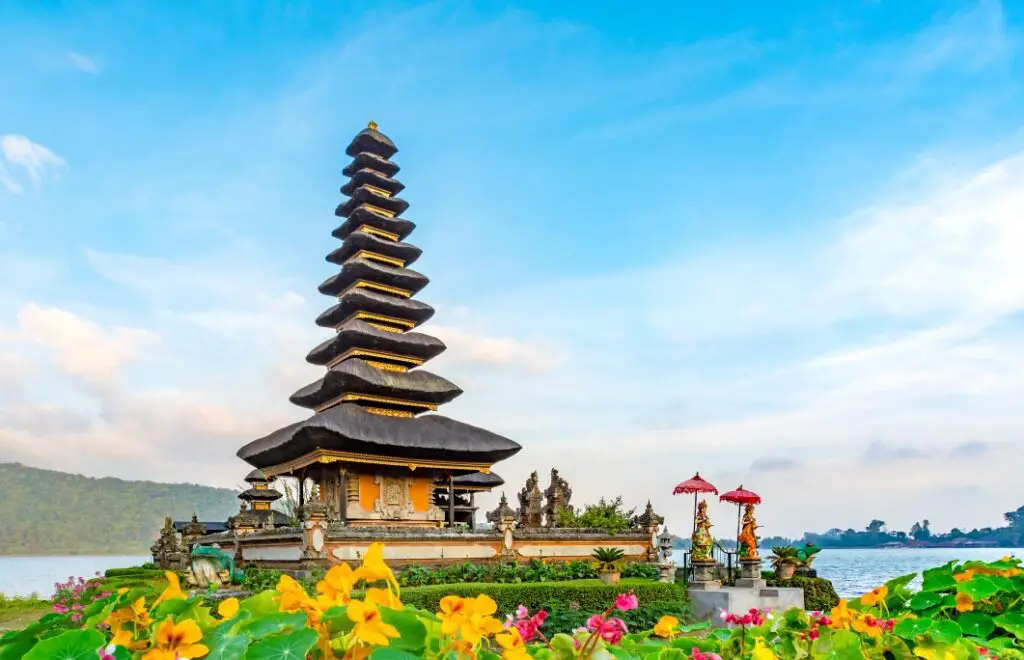
Pura Ulun Danu Beratan Temple is situated in the northern part of Bali in the monotonous region of Bedugul Regency where the temperatures are lower than the rest of Bali and the air much fresher. It is one of the most spectacular temples in Bali and an important place of worship for Hindu people. The temple is an icon of Bali that can be found on many postcards and on Balinese 50k rupiahs banknotes.
This magnificent temple is dedicated to the Balinese goddess of water, lakes, and rivers called Danu. It also consists of four sacred structures, and it was built in the 16th century. But the place itself is believed to be a place of worship since as early as the megalithic period!
Pura Ulun Danu is actually a temple complex that consists of several temples and shrines surrounded by a well-trimmed garden. The main temple is built on lake Beratan with a stunning mountain backdrop. The view is truly idyllic with the colorful temple reflecting in the calm waters of the lake, giving the impression that the temple is floating on the surface like a water lily. Often a fog comes down from the surrounding mountains making the view even more special, almost mystical. Take a walk in the lush garden or hire a small boat to get a different view of the temple.
There is an entry ticket of 50k IDR and a small parking charge. The temple is best visited in the morning when there are fewer visitors. During the day, it gets busy with tourists and Hindu people visiting this vital place of worship. The temple complex is located in a small village where you can find shops, several souvenir vendors, and some local restaurants. It should take just over an hour if you’re traveling from Ubud and about two hours from Uluwatu, Seminyak, and Kuta areas.
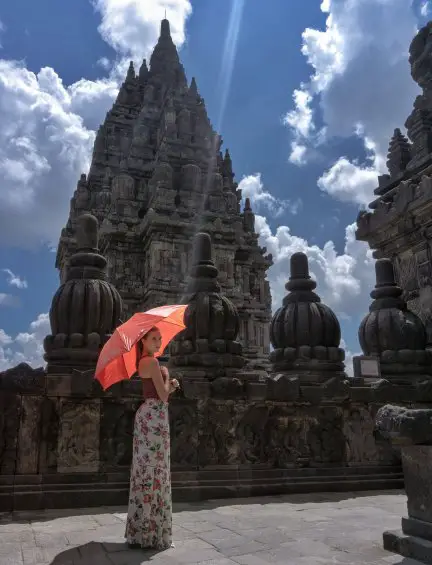
Visited by Cassie from Cassie the Hag
Visiting Candi Prambanan, a huge Hindu temple based on the large Indonesian island of Java, is definitely one to add to your bucket list. I really enjoyed visiting during my solo Indonesia trip last year. Built-in the 9th century, it has unfortunately been partially damaged by the huge earthquakes that have disrupted the country over the years, yet many of the tallest structures remain intact. In fact, the complex comprises over 200 temples, so it’s not surprising to hear the temple took two years to fully complete. The locals still hope to reconstruct the damaged parts of this World Heritage Site, but there is still a huge amount to enjoy. The entire site is very impressive to walk around and if you climb up the stairs of many structures you can walk inside and find hidden statues in the darkness, usually made of Hindu deities. I wasn’t expecting the statues to be there, which made the trip up feel more unique!
A popular sunset spot. Prambanan is also a wonderful place to see traditional Javanese dance performances, right on the site of this cultural spectacle. Most travelers choose to stay in the nearby city of Yogyakarta from where you can book a tour or day trip to both Prambanan and Borobudur temple. Borobudur is also a must-see in the region since it is the largest Buddhist temple in the world and the view over the sun rising over the temple and surrounding mountains has become synonymous with Indonesian tourism. These days, Java is a predominantly Muslim island, and these temples are a reminder of the country’s diverse heritage.
Prambanan is a popular place for local tourism and school trips, so you may find you’re asked a lot of questions and end up in many selfies! But the locals are charming and grateful, and often are kind enough to share some more local facts about the temple too. My driver even lent me his umbrella to shade me from the hot sun and kept reminding me to drink water, since it does get very hot. If you’re visiting Indonesia, I would really recommend stopping here.
Beautiful Hindu Temples in ENGLAND
Neasden Temple: Britain’s first Hindu temple
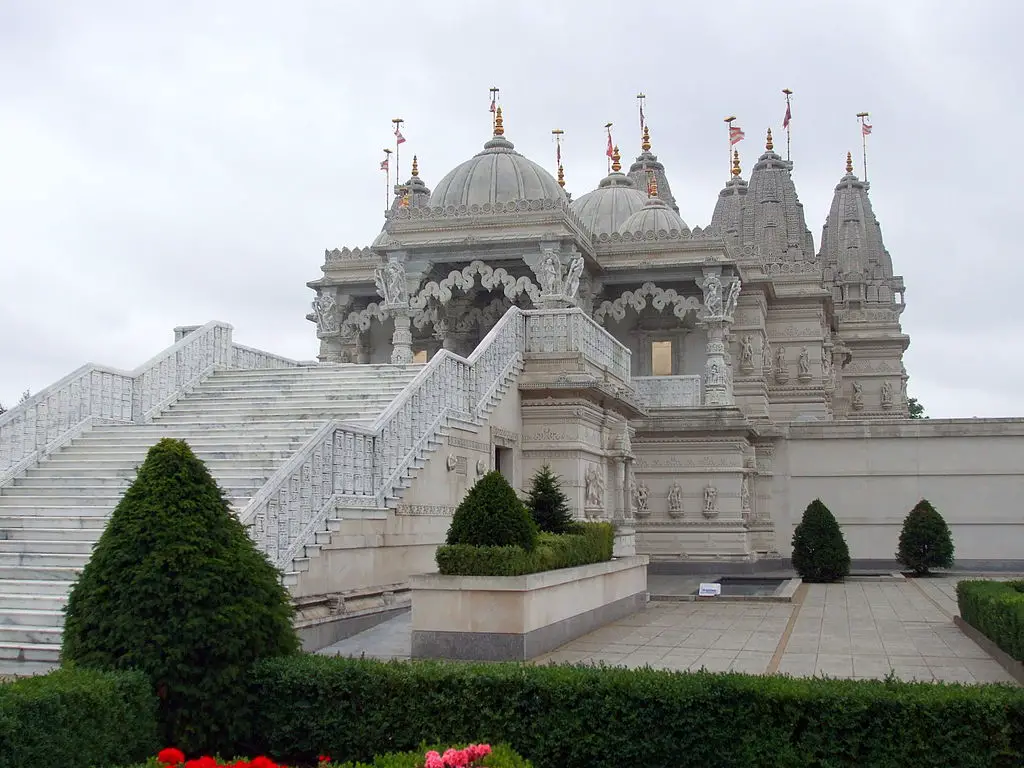
The Swaminarayan Temple, also known as the Neasden Temple, is located in London and was Europe’s first stone temple and England’s first authentic Hindu temple. It is constructed mainly of Italian marble and Bulgarian limestone and was at one time the largest of its kind.
Beautiful Hindu Temples in BELGIUM
Radhadesh Temple: surrounded by the green mountains of Belgium
Visited by Bhushavali from My Travelogue
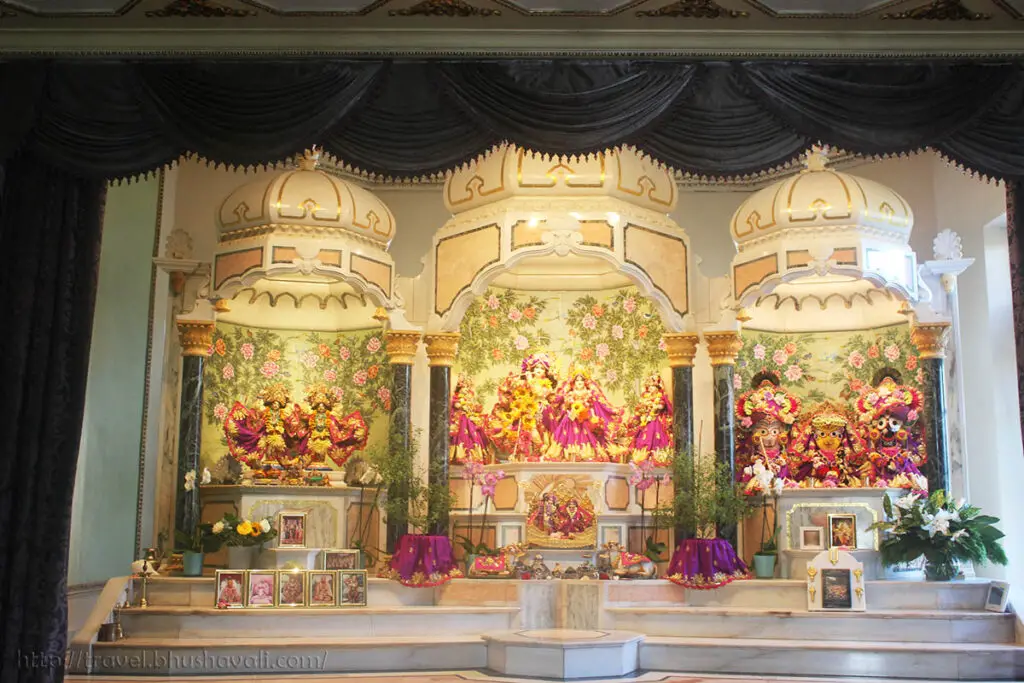
Belgium has a few Hindu temples and the most picturesque of them all is Radhadesh, Ardennes in South Belgium. I’ve been wanting to visit Radhadesh for a long time but the biggest challenge was that it is not connected by public transport from Brussels and we couldn’t rent a car here in Europe as our Indian license is invalid in the EU! Recently I started cycling and the easiest way to reach this beautiful Hindu temple was to hire an e-bike from the nearest town of Durbuy, located 5km away. Durbuy can be reached from Brussels by train.
Radhadesh comes under ISKCON chain of temples. The whole setting of Radhadesh and the route to reach it are spectacular. It is located in the midst of Famenne Ardennes, the mountain range & forest that covers southern Belgium & northern France and housed in a castle of Petit Somme in the outskirts of Durbuy, Belgium. Surrounded by the greenery of Famenne-Ardennes on all sides, housed in the historic Chateau de Petite Somme, it is a reminder of Krishna’s Vrindavan itself! With the view of Ardennes hills, riding the cycle on these curved roads was just such an amazing feeling. The castle, Chateau de Petite Somme, not only houses the temple, but also a restaurant, museum, and a retreat as well, all under the wings of Radhadesh.
It was a different world as I entered. First, I had an authentic, pleasing, Indian vegetarian meal at the Govinda Restaurant here. Hands down, it’s the best Indian vegetarian restaurant in the whole of Belgium. It most definitely reminded me of home. Then I had a look at the Museum of Spiritual Arts where my little gal had so much fun pointing out which sculpture and picture are of which God. There is a guided tour to go atop the castle. Finally, I went into the temple’s sanctum sanctorum and it was amazing. As a true representation of being Krishna devotees, the group prayers were often performed with singing and dancing. The decoration was beautiful and Lord Krishna was very, very handsome! It was definitely a unique experience to be in Krishna’s abode in a Belgian castle.
Beautiful Hindu Temples in INDIA
Ellora Caves – the largest single rock excavation in the world
Visited by Joel Baldwin from World Heritage Journey
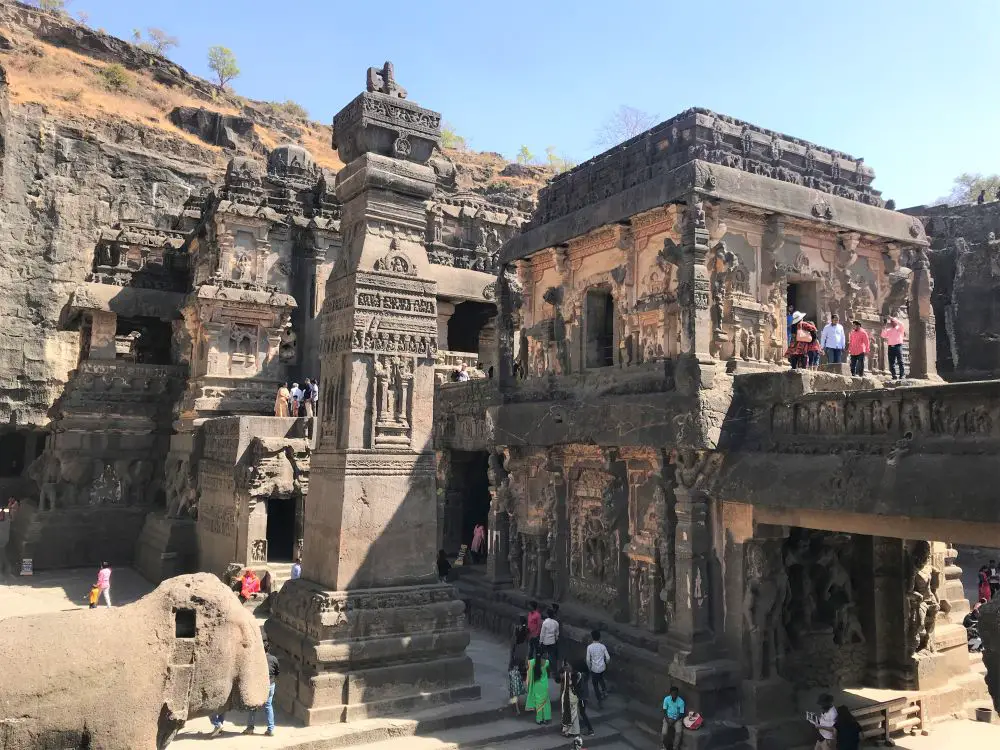
I’m currently in the midst of a grand mission, to visit all 1121 UNESCO World Heritage Sites. I recently reached the milestone of 500 sites, which was a great opportunity to reflect on all of the places I’d visited on the World Heritage Journey. Naturally, religious sites of all kinds feature heavily on the World Heritage List, and India, with its long and diverse religious traditions, is well represented. From the glittering Mughal Islamic monuments of northern India to the colorful Hindu temples of the south, the ancient Buddhist stupas at Sanchi, and the incredible Sikh temples of the northwest, there’s an incredible and beautiful array of religious art and tradition to explore in India.
In my opinion, one of the absolute best places to see these traditions is at Ellora Caves, a large religious complex located outside the city of Aurangabad in Maharashtra state, 300 kilometers northeast of Mumbai, India. When researching World Heritage Sites in Maharashtra, Ellora Caves had immediately sparked my imagination, so I ensured it was top of the list for our first visit to India.
And it absolutely didn’t disappoint. Ellora Caves is a collection of over 100 separate caves, all carved into the same rock faces. The caves date back to around 600-1000AD, and although some caves are Buddhist and others are Jain, the absolute highlights here are the Hindu caves.
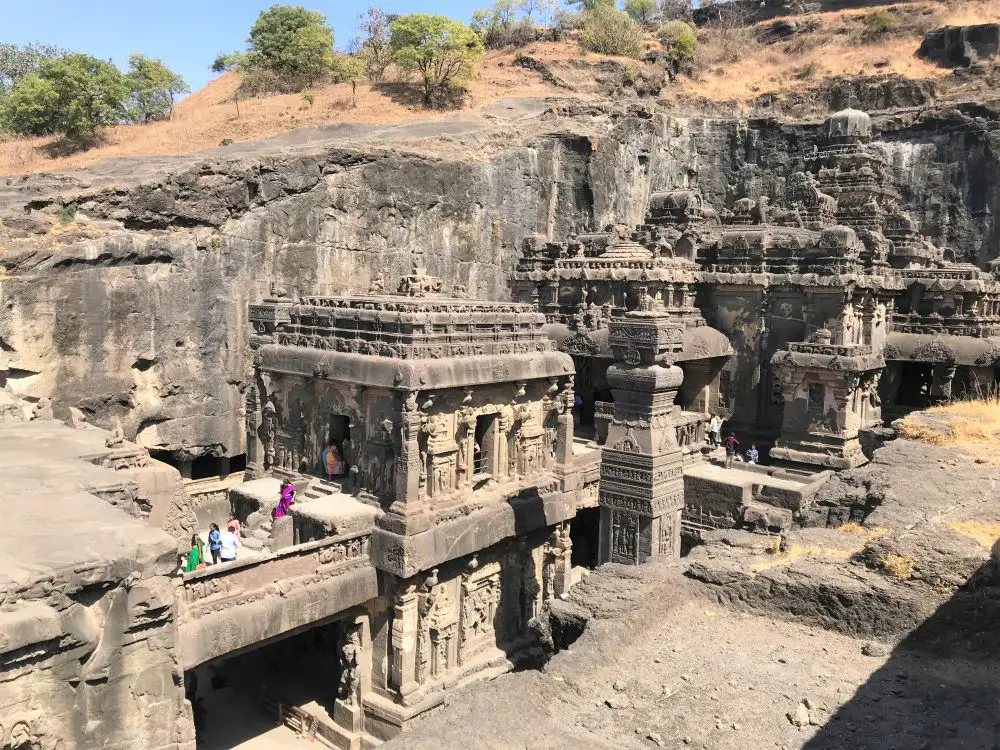
Most famous, and the one I found by far the most impressive, is cave #16, known as the Kailasa temple. It’s not really even a cave – it’s a huge area that’s been carved out of the mountain, where the remainder forms a chariot-shaped temple to Lord Shiva. It’s considered to be the largest single rock excavation in the entire world, and it’s honestly hard to disagree with that! The shrine towers over you and leaves you feeling insignificant, which was no doubt part of its intended purpose.
The entire temple is covered with carvings, statues, and other decorations, which I spent several hours exploring thoroughly. There are fantastic sculptures of Shiva, his bull Nandi, Vishnu, elephants, and many others. The courtyard also features beautifully detailed carvings of scenes from the Mahabharata and Ramayana epics, which are worthy of close inspection. And you have to keep in mind the entire time that all of the sculptures, carvings, pillars, and decorations have all been created by removing stone – difficult to imagine!
Overall, Ellora Caves is one of the most impressive Hindu temples I’ve ever visited. Although it’s well-known in India (and heavily visited by domestic tourists), it’s still not commonly visited by foreigners. And in true Indian fashion, getting there and back was half the fun – our journey back to Aurangabad involved 15 passengers squashed into an 8-seater van, with the driver sitting on someone’s lap! It was okay until he went off-road to dodge cows and slower cars. But that’s partly why I love visiting India: magical sites and crazy experiences, often in very close proximity!
Modhera Sun Temple: a beautiful shrine to the Hindu Sun God
Visited by Soumya from Stories by Soumya

One of the most beautiful Hindu temples in India and absolutely one of my favorites is the Modhera Sun Temple in Gujarat. Located in the lesser-known town of Modhera, this temple is one of the few shrines in India dedicated to the Hindu Sun God.
Built in the 11th century by the Solanki dynasty of Gujarat, Modhera Sun Temple has a ton of history attached to it. After being used as a holy place of worship for centuries, it was pillaged and plundered several times by usurpers from faraway lands and eventually left without an idol. Ever since, no worship has been offered here and Modhera Sun Temple stands in ruins.
However, it is far from being unattractive. In fact, there is an enigma about the ruins of Modhera that keeps drawing me to it multiple times. Be it the empty inner sanctum, the stepped water tank surrounded by interesting legends, or the incredibly beautiful carvings on the walls and ceilings – Modhera has my heart. And the carvings are definitely my favorite.
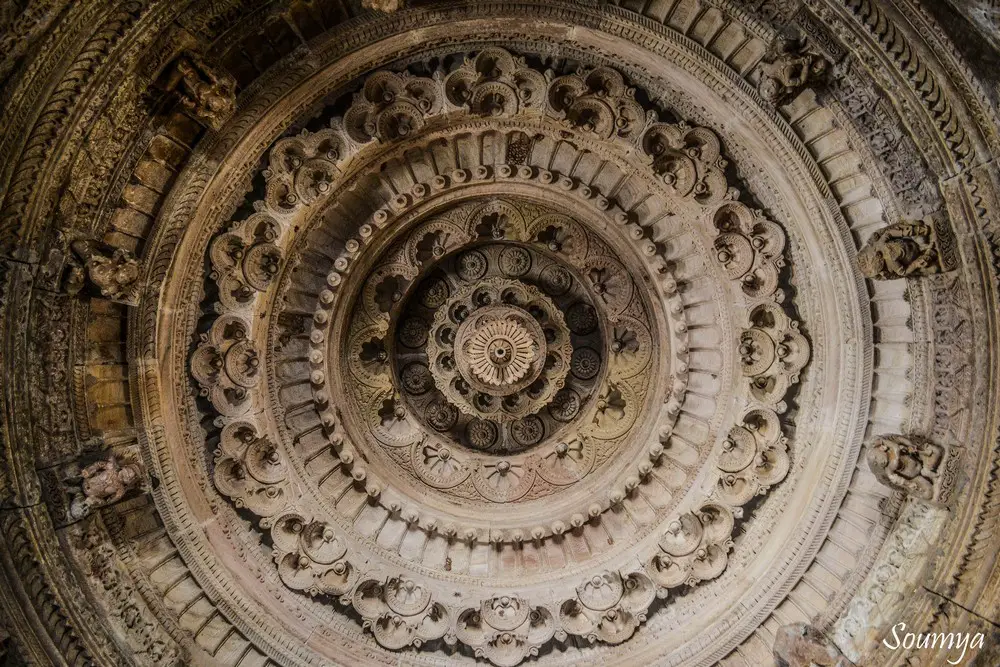
Modhera Sun Temple was built in the Maru-Gurjara architectural style that is characterized by extreme detailing of monuments. For example, if you look up at the ceiling of the Sabha Mandapa (public hall), you will see an intricately carved rosette replete with flowers, patterns, and mythological creatures. Pillars of the Sabha Mandapa and Guda Mandapa (inner sanctum) are elaborately carved and feature attractive toranas (floral arches) on top. Carvings on the walls depict various stages of human life from birth to death.
It is interesting to note that the temple of Modhera is located exactly on the Tropic of Cancer. In the olden times, this location and good craftmanship ensured that the first rays of the rising sun illuminated the idol of Sun God every equinox thus giving the sun temple a mystical feel. Needless to say, a visit to the Modhera Sun Temple is not just about exploring another stunning monument from yesteryears, it is also about delving deeper into the art, culture, and lives of people from ages ago. If you wish to visit this beautiful temple on your next trip to India, fly into Ahmedabad and take a private taxi (Uber/Ola) from there. Between October – March is considered a good time to visit but make sure you carry sunscreen, sunglasses, and sufficient water with you because it can get really hot here even during winters.
Murudeshwar Temple: 2nd tallest statue of Lord Shiva
Visited by Pooja Shah from Fairytale Studios

Murudeshwar is a temple town on the west coast of the Indian state of Karnataka. It is one of the significant Lord Shiva temples in India and one of the most beautiful Hindu temples around the world. The peculiarity of Murudeshwar temple is that it is located on a peninsula, surrounded by water on three sides.
Another uniqueness of Murudeshwar temple is that it has a massive statue of Lord Shiva next to it. By massive I mean, 123 feet tall! It is the second tallest statue of Lord Shiva in the world (the first being in Nepal).
The temple of Murudeshwar is built out of granite in age-old Dravidian style architecture. It is believed that when the demon God Ravana was unable to carry the Atma-Linga (the soul of Lord Shiva, that was supposed to make him immortal and indestructible) to Lanka, he got furious and uprooted it. With all the force, he threw the pieces of the Atma-Linga in four different directions. Murudeshwar is one such place where a piece of Atma-Linga fell. Murudeshwar temple was constructed by Shiva devotees in the very same place where the Atma-Linga fell. Hence, it is revered as a place with high sacred value.
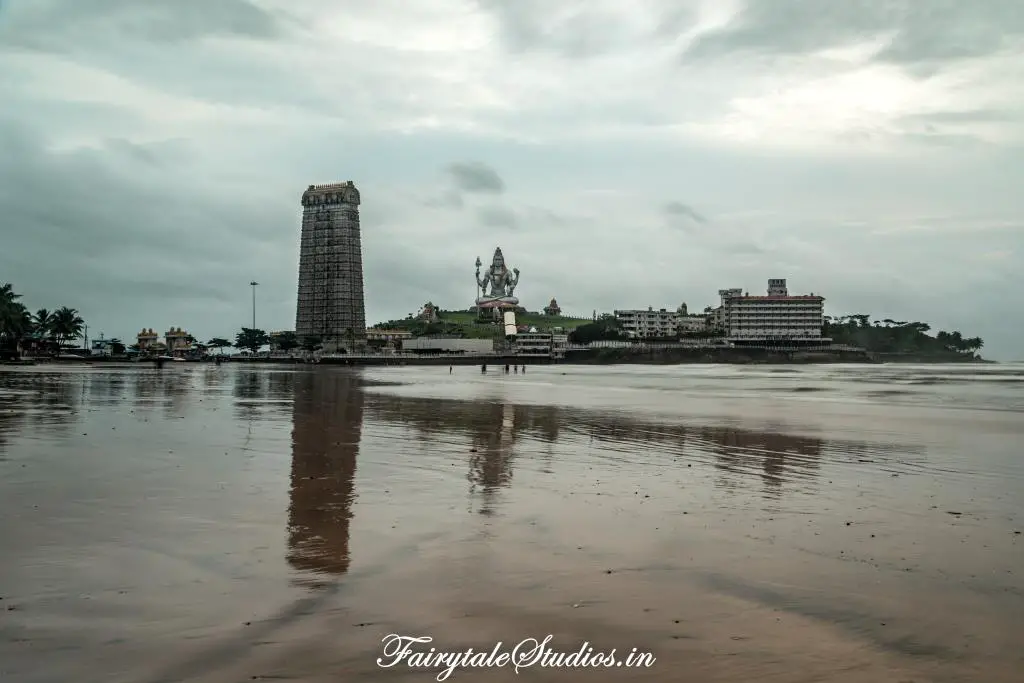
Another famous landmark in Murudeshwar is a 22-story tall Rajgopuram. It is a huge tower-like structure usually constructed at the entrances of temples. The Rajgopuram adjacent to Murudeshwar temple is also built in Dravidian style and is the second tallest Hindu temple entrance tower in the world. The best part is that it is equipped with an elevator and at a nominal fee, tourists can get to the 18th floor of the Rajgopuram. I can’t even start describing the incredible views that one gets from the top. It provides a breath-taking panoramic view of the Murudeshwar town on one side and the Shiva statue with the endless sea in the backdrop on the other.
Murudeshwar temple is a must-visit, not just for religious purposes, but for the fantastic place that it is. The huge Shiva statue keeps you captivated no matter where you are in the small town of Murudeshwar. The entire place has an aura of its own, something that is difficult to explain in words and can only be experienced when you visit it.
Shore Temple in Mahabalipuram: largest open-air rock relief
Visited by Sonakshi and Mainak from Places in Pixel

The Shore Temple in Mahabalipuram is not just one temple, but is actually a group of monuments of huge historical and cultural significance. That is one of the main reasons why we wanted to visit and learn more about the history of some of these beautiful Hindu temples.
Mahabalipuram is a small beach town 60 km south of Chennai in the southern state of Tamil Nadu in India. Hence, while staying in Chennai, we had been to Mahabalipuram multiple times, primarily for a weekend break to relax in a beautiful beach resort. Although Mahabalipuram is known for its beach resorts, it is even more famous for the beautiful Shore Temple and the surrounding monuments which were declared a cultural UNESCO World Heritage Site in 1984.
The Mahabalipuram site is composed of nearly 40 sanctuaries, including the largest open-air rock-relief in the world – ‘Descent of the Ganges’. This rock relief depicts 2 stories – (1) ‘Decent of Ganges’ showing the Hindu river goddess Ganga descending on earth, and (2) ‘Arjuna’s Penance’ from the Indian Epic Mahabharat.
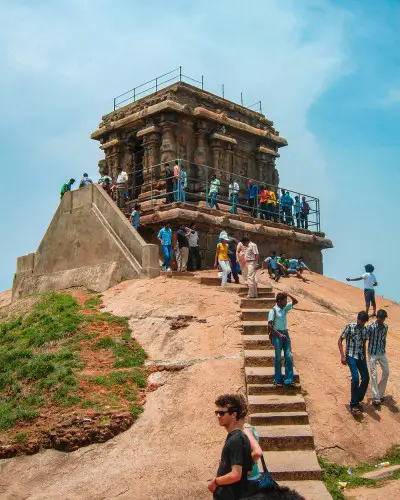
The tourist attractions incorporate structural temples like the Shore Temple and Olakkanesvara Temple, Mantapas or cave temples like Mahishasurmardini Cave Temple, Krishna Cave Temple, Panchpandava Cave Temple and Varah Cave Temple. Travelers like us with an affinity for culture experiences will definitely find the monuments more interesting than the beach.
One of the things that we loved was the pamphlet they gave us after purchasing the entry tickets. It explained concisely the history of the monuments and also highlights their cultural significance. We learnt that Mahabalipuram, a.k.a Mamallapuram, used to be the capital region during the reign of Pallava Dynasty in the 7th century AD. The Pallava rulers, similar to many other rulers in the southern part of India, were popular for their inclination towards Tamilian art and culture. This entire complex of monuments, including the Shore Temple and the accompanying rock-carved caves were built during Pallava period.
You might be aware of the devastating tsunami of 2004 that caused havoc in Sri Lanka and the southern part of India. Well, it might surprise you that the entire temple complex withstood the tsunami without any major damages. This bears testimony to the amazing skill of designers and the sculptors of that era.
Gangotri Temple: location of the origin of the holy Ganges River
Visited by Samantha Shea from Intentional Detours
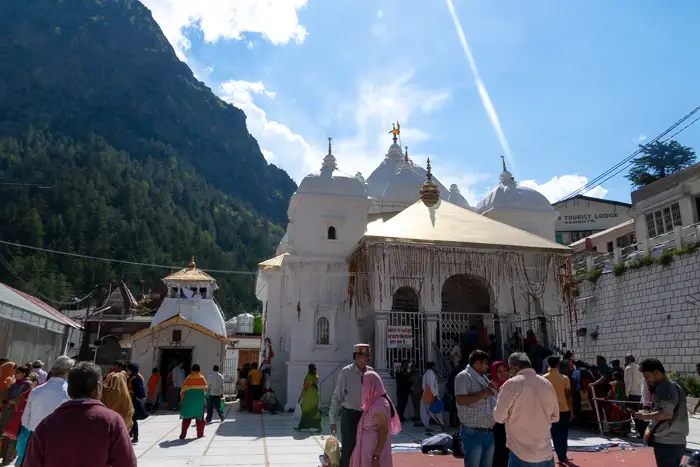
One of the most beautiful Hindu temples in the world is located in Gangotri, a small village that sits more than 11,000 feet above sea level in India’s Uttarakhand state. The famous and beautiful temple- which is also called Gangotri- sits amongst the mountains and beside the Bhagirathi River.
I visited this temple while I was in Gangotri for the Gaumukh Trek, which is a journey through Gangotri National Park that takes trekkers to what is believed to be the very beginning of the holy Ganges River.
I consider Gangotri to be one of the most beautiful Hindu temples around the world not just because of its physical beauty, but also because of what it represents. The temple is a part of the Char Dham Yatra, a pilgrimage that Hindus must undertake at least once in their lives, and the circuit includes four temples within the Garhwal region of Uttarakhand.
Gangotri is particularly special due to the fact that it is believed to be the place of origin of the Ganges River. Hindus believe that the Goddess Ganga took the form of the now holy river after Lord Shiva released the raging waters from the locks of his hair.
Thousands of pilgrims visit the temple every day after it opens its doors come spring. Due to its magical location, the temple has an aura about it that is simply unmatched- very few Hindu temples can boast about being nestled in such mountainous peaks.
The journey to reach Gangotri Mandir is quite arduous, but worth it nevertheless. Travelers must first make it to the small town of Uttarkashi, and from there, take a shared jeep/van on a four-hour journey through stunning yet windy forested roads to reach the holy village. Though the Gaumukh Trek- which begins at the temple- requires a bit of physical fitness, anyone can visit the temple- in fact, many elderly people do so as to complete the Char Dham Yatra.
Akshardham Temple: spiritual campus with water show & boat ride
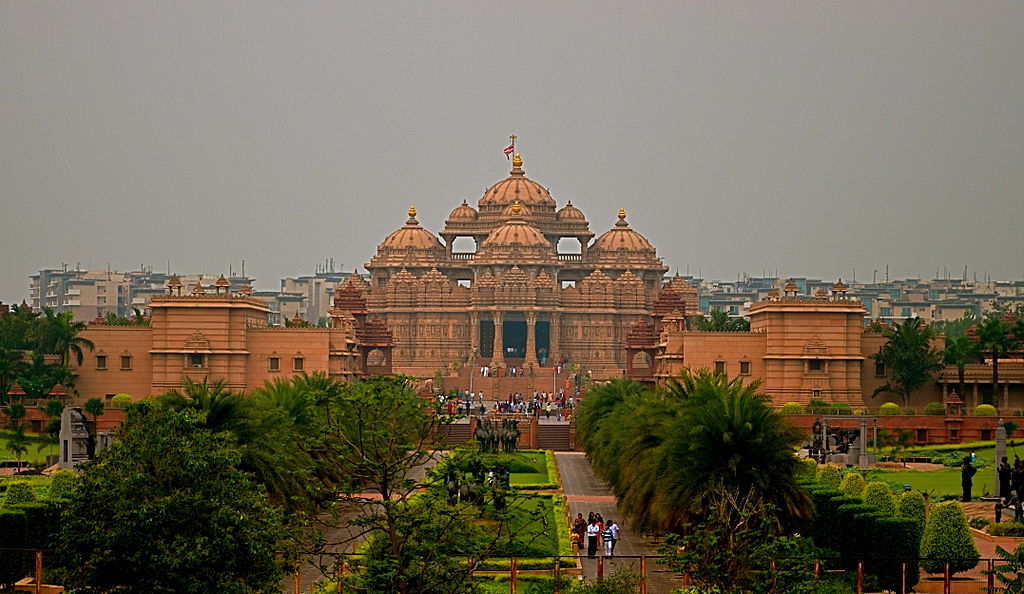
The Akshardham Temple is a huge religious campus in New Delhi, India. It is constructed of pink sandstone and Italian marble, containing no metal in the construction at all and no metal or concrete supports. It is truly an architectural wonder! It is also home to 148 life-size elephants, honoring the importance of the elephant in the Hindu culture
On the spiritual campus, there are many displays that the devotee can participate in. In addition to the beautiful Hindu temple, there is a thematic natural garden, a water fountain and multi-media water show, exhibitions and an IMAX film of the education of the teenage yogi, and a boat ride depicting robotic heritage scenes.
Brihadishvara Temple: a visit to the Neem Tree helps in pregnancy
visited by Khushboo Motihar from Munniofalltrades

The Brihadishvara Temple also called the Rajarajesvaram or the Big Temple is a UNESCO World Heritage Site in the town of Thanjavur, Tamil Nadu, India. Built in the 11th Century by King Raj Raja Chola 1, this temple is one of the ‘Great Living Chola Temples’ in India.
The architectural style of this temple is called Madakkkoil or Perunkoil, which means a temple or a structure built on natural or man-made mounds. The Big Temple has a huge complex where one can observe different sculptures and murals depicting Hindu Gods and Goddesses. The beauty of this temple is unparalleled and if you love history and architecture, you can spend hours admiring the temple complex.
Entry to the temple is free and it is recommended that you take a local government-approved guide to help you understand not only the history but some interesting folklore like the neem tree within the temple complex that is locally famous for helping women get pregnant.
While tourists visit the temple all through the year, the winter months of October to February are pleasant. During the festival of Mahashivratri (February or March), the temple hosts an annual dance festival for 10 days showcasing classical dance forms from all over India. You must make the relevant bookings at least 3 months in advance as people from all over the world congregate to witness the different dance forms. This is a wonderful way to get acquainted with different types of performing arts in India.
While visiting the temple, it is important that you should be modestly dressed. At the entrance, you will be required to remove your shoes. If you are visiting during the summer months, I highly recommend that you carry a pair of socks as it can get difficult to move around. After your trip to Thanjavur temple, you can pick up some interesting books on the history of Thanjavur or Thanjavur’s famous dancing dolls as souvenirs.
Virupaksha Temple: see the chariot procession in the Virupaksha Car Festival
visited by Neethu Nair from Our Backpack Tales

The Sri Virupaksha temple located in Hampi, Karnataka, India, is one of the most beautiful Hindu temples I have ever visited and is a must visit place in Hampi. Hampi, also known as the Hampi Group of Monuments is a UNESCO World Heritage Site and is such a magical place to visit owing to its historical significance and an air of mystery surrounding it.
One of the most famous landmarks in Hampi, the Virupaksha temple is dedicated to Lord Virupaksha, a form of Lord Shiva. Considered to be the main center of pilgrimage in Hampi, it is also one of the very few temples that are fully functional in Hampi since its construction. The temple was constructed in the magnificent Vijayanagara style of architecture and it exudes the glory of the Vijayanagara empire which was once known to be the most prosperous kingdoms in medieval India. With sprawling courtyards and carved towers, this temple is an architectural marvel. You can find many intricately carved sculptures all around the temple walls and pillar carvings that depict tales from Ramayana and Mahabharata. The temple is said to have been renovated and extended through the years.
If you visit during the months of March or April, you may be witness the ‘Virupaksha Car Festival’ which is the biggest festival in Hampi. The main highlight of the festival is a procession carrying images of the god and goddess in a wooden chariot. Diwali and Shivaratri festivals are also well celebrated here.
The Virupaksha temple is located on the banks of the river Tungabadra and is very easy to reach from Hampi Bazaar. On our two day visit to Hampi, we had kept the Virupaksha temple as our last spot. So we took the ferry from Hippie Island which takes visitors from both sides of the river at specific times of the day. So if you ever wish to ride the ferry please do remember to manage your time! You can also take coracles rides which are much more fun. We were also lucky to meet ‘Lakshmi’ the sweet little temple elephant who is the star attraction here!
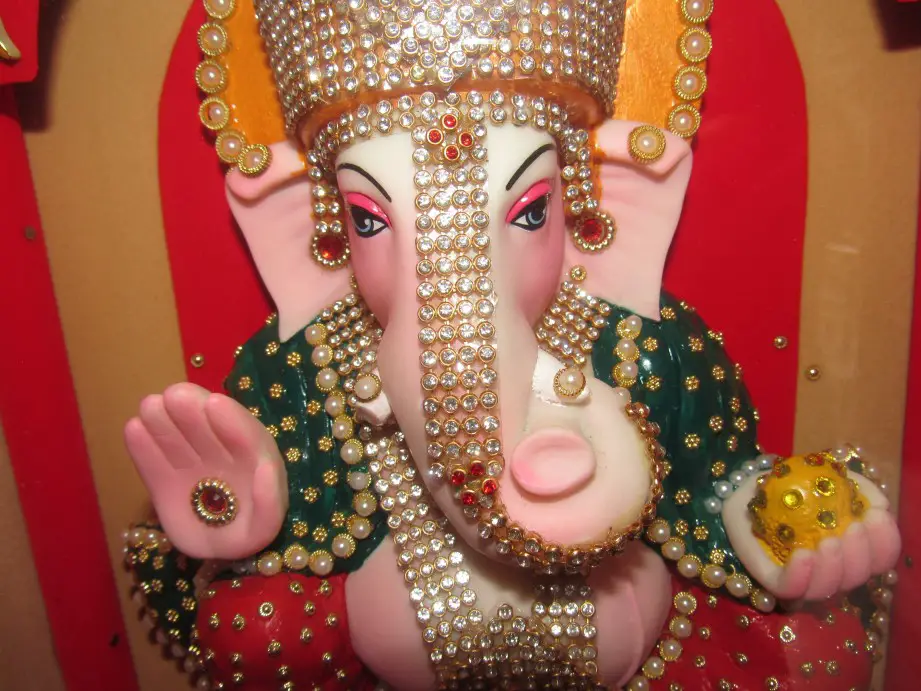
Have you been to any of these beautiful Hindu Temples?
Those are the 16 most beautiful Hindu temples around the world as selected by travel content creators from across this great planet. They are diverse, colorful, architectural wonders that deserve a place on your Bucket List. Which one holds a special place in your heart?
Did we miss any beautiful Hindu Temples from our list? Let us know in the comments!
LIKE THIS POST? PIN IT FOR LATER
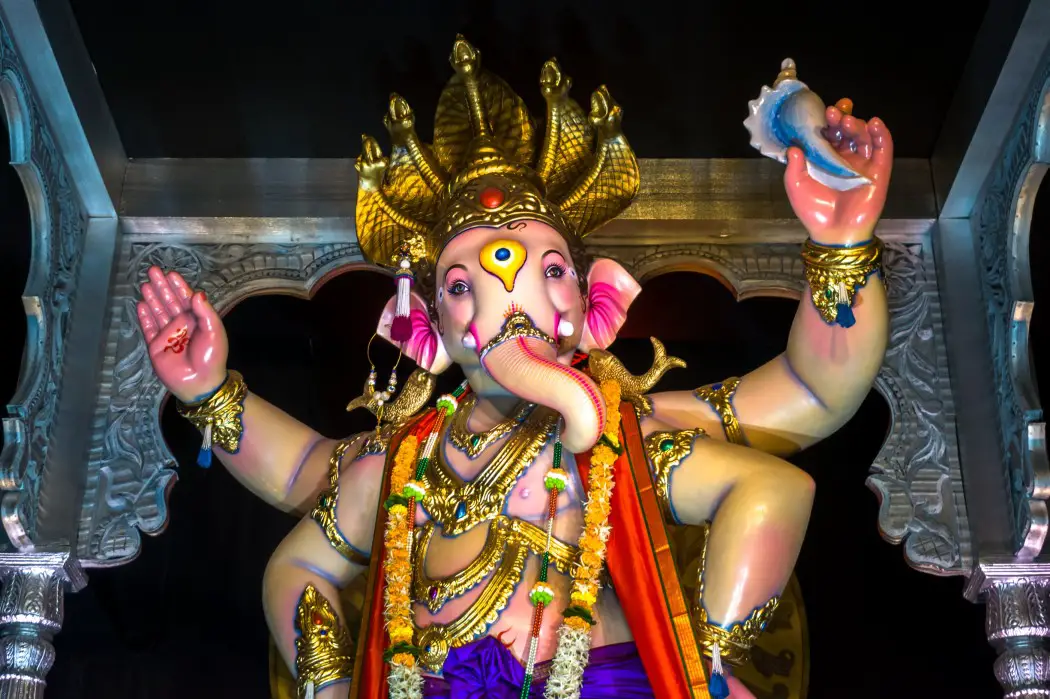

So much history to see and learn. Such great photos. Makes me sad that we can’t travel. Can’t wait to travel again.
These temples are beautiful! I have never been to place that has them, but the pictures are awesome and I would love to visit one day to see in person.